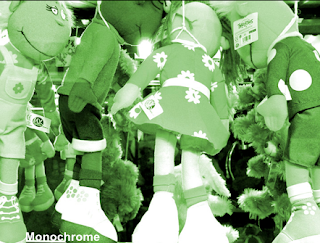1. Rotary Printing
2. Digital Printing
3. Screen Printing
4. Pad Printing
ROTARY PRINTING//
Offset Lithography (Litho) - Uses an aluminium plate for one off uses. Value for money, uses a 'Web Offset' Machine.
Advantages of offset printing compared to other printing methods include:
- Consistent high image quality. Offset printing produces sharp and clean images and type more easily than letterpress printing because the rubber blanket conforms to the texture of the printing surface.
- Quick and easy production of printing plates.
- Longer printing plate life than on direct litho presses because there is no direct contact between the plate and the printing surface. Properly developed plates running in conjunction with optimized inks and fountain solution may achieve run lengths of more than a million impressions.
- Cost. Offset printing is the cheapest method for producing high quality prints in commercial printing quantities.
Disadvantages of offset printing compared to other printing methods include:
- Slightly inferior image quality compared to rotogravure or photogravure printing.
Rotogravure (Gravure) - Uses copper plates and is often used for high volumes of prints because its more durable and has a better ink hold, probably because it prints in dots. Print jobs usually include; Newspapers/ Magazines/ Money.
Flexography (Flexo) - Uses a rubber polymer plate which mirrors the image. There's a lot more flexibility and the image is usually raised 2-4mm above the surface. This type of printing technique is used substantially in the food industry.
DIGITAL PRINTING//
There's no offset or plate involved, the design is ran straight through the printers. Short runs/ Specials on a range of print media from paper to metal.
SCREEN PRINTING//
Uses a stencil and woven mesh which can obtain high quality results such as digital prints, when time and precision is involved. It's inexpensive and is often used for shorter runs because of the time involved.
Screen Printing can also be used to transfer images onto 3D objects as this video demonstrates...
PAD PRINTING//
A transfer thats applicable to any surface you can find, 2D or 3D. The prints can wrap around objects, for e.g. Golf balls, helmets, cans etc...
Useful links...
The art of Litho-Printing.
This video basically demonstrates the process of CMYK and what can be achieved when you mix the 3 subtractive colours. Through a printer or through screen print...
PAD PRINTING///
(Refer to handout for more useful links)
VERY USEFUL**
Identifying high-volume printing processes.
Further Research
Spot Colours // Instead of using the CMYK model of colour, Spot colours are a specific mix of paint/ ink. You can usually find these spot colours in swatch guides which are linked with a code...it's this code that will allow the printers to mix the exact colour you've selected.
The most common colour authority in Europe is PANTONE, a formula guide that consists of unique names and number followed by either a 'C' 'U' or 'M'. The letters refer to the paper stock on which it is printed. 'C' for coated, 'U' for uncoated and 'M' for matte.
As a useful reference I thought it would've been a good idea to collate a list of Leeds based printers who work with commercial orders.
http://www.bowmans77.co.uk - Digital and Lithographic Printers
http://www.lazerbeamduplication.co.uk/packaging/ - CD Packaging
http://www.pressision.co.uk - Total brand integrity** Useful resource
http://www.gdpl.co.uk/our-work/ - Gold foil, Foil & Emboss, Blind Embossing, Metallic Foil...
Design Inspiration...
Print marks and crop marks seem to be a popular choice among the majority of booklets concerned with printing, it gives the audience an instant recognisable feature of print in a subtle manner.
Useful attributes to adopt for my designs?
I really think this sort of approach is perfect from a design point of view, not only does it look aesthetically pleasing but it instantly communicates the content of the page. If my publication wasn't largely focused on the informative side of things, I would of loved to produce something similar, so abrupt and design conscience...
































Selling the magazines on newsstands, while I don't suggest it,they may require a certain number of copies for their distribution channel. I don't suggest selling on newsstands in the beginning because if they don't sell,they will be destroyed and thrown away. We can't afford that yet.
ReplyDeleteboston commercial printing
Hi there I am so thrilled I found your website, I really found you by mistake, while I was browsing on Yahoo for something else
ReplyDeleteBest Screen Printing Machine